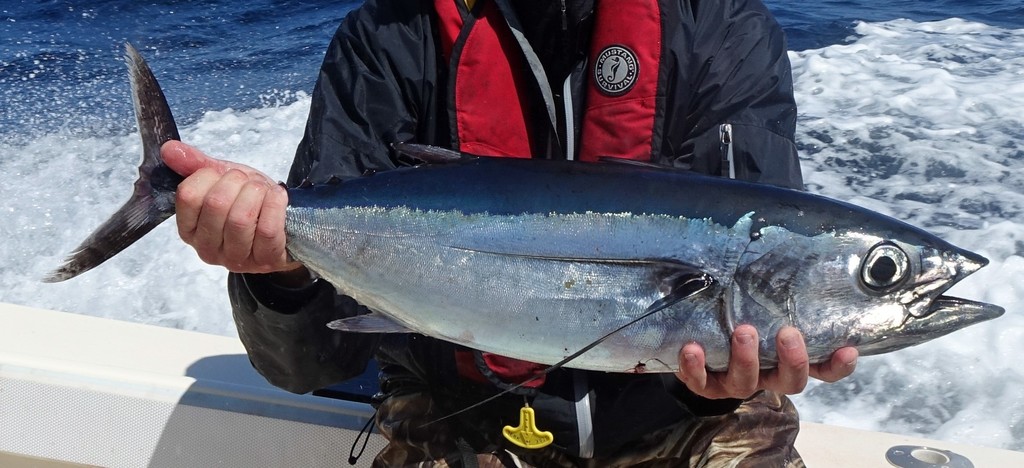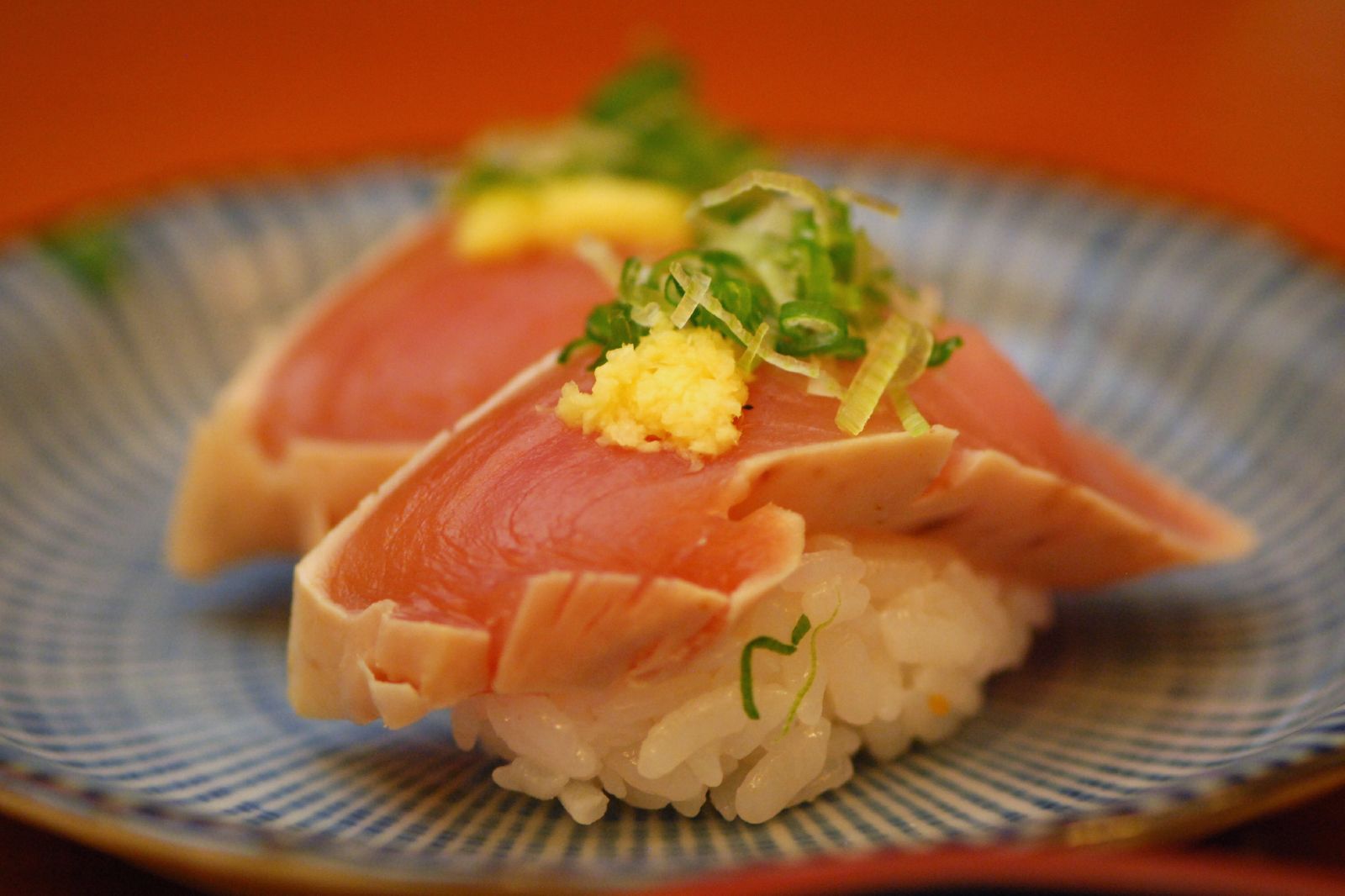Thunnus alalunga
North Coast (Oregon Border to Point Arena)
North Central Coast (South of Point Arena to Half Moon Bay)
Central Coast (South of Half Moon Bay to Point Conception)
Santa Barbara (Point Conception to Point Dume)
South Coast (Point Dume to Mexico border)
Firm fish
Oily fish
Wild caught
The Science

Taxonomic description
- Can be identified by its metallic dark blue back and silver belly as well as its dark yellow first dorsal fin and pale yellow second dorsal fin. A deeply forked, crescent shaped tail fin helps generate the power needed to maintain its impressive speed. [1]
- This fish can reach up to 1.5 meters in length. [2]
Distribution
- Found in the tropical, sub-tropical, and temperate zones of the Indian, Atlantic, and Pacific oceans. [1]
Life history
- It can live up to 10 -12 years. [1]
- Reaches sexual maturity at 5-6 years and spawns from March through July (possibly multiple times per year). Females will broadcast spawn, releasing between .8 to 2.6 million eggs every time they spawn. Fertilized eggs hatch within 24-48 hours. [1]
Habitat
- It is found in waters of 13.5° to 25.2° C. [2]
- This fish is a top carnivore in the food chain, feeding on anchovy, squid, and sardines. It is preyed upon by humans, sharks, billfish, and other tunas. [1]
- Primarily feeds by sight so it is limited to daytime feeding hours, although it has been known to occasionally feed at night. [1]
The Fishery

Seasonal availability
- May be fished commercially year-round, but highest availability is typically from July to August. [3,5]
Regulatory and Managing authority
-
It is internationally overseen by the Inter-American Tropical Tuna Commission (IATTC) and the Western and Central Pacific Fisheries Commission (WCPFC). [1]
-
Along the Pacific West Coast, this fishery is overseen by NOAA fisheries and, as established by the Magnuson-Stevens Act, the Pacific Fishery Management Council through the West Coast Highly Migratory Species Fisheries Management Plan. [1]
-
As established by the Marine Life Management Act, the California Department of Fish and Wildlife (CDFW) collects data on this fishery through the Pelagic Fisheries Ecosystems Program. [9,12]
-
The American Albacore Fishing Association combines input from the industry and government entities to inform regulatory and management measures for this fishery. [11]
Gear type
- Fishing methods for catching albacore include longline, gillnet, pole and line, purse sein, trolling. [3,4]
- Along the Pacific West Coast, most commercially landed albacore tuna is caught by troll and pole-and-line gear. [1]
Status of the fishery
- According to 2015 and 2017 stock assessments, the North and South Pacific stock is not overfished or at risk of being overfished due to successful regulation and monitoring programs. [1]
- Population size is above target levels. [1]
- Protective regulations include limits on longline permits, protected species workshops, and a vessel monitoring program. [3]
- International Scientific Committee for Tuna and Tuna-like Species in the North Pacific provides scientific analysis and recommendations to aid in conservation efforts. [1]
Potential ecosystem impacts
- Since the gear associated with Albacore fishing rarely touches the seafloor, impacts to habitat are minimal compared to other methods. [1]
The Seafood

Edible portions
- The entire fish is edible, and can be found fresh, canned, or smoked. The meat is usually cut as steaks or loins. [6]
Description of meat
- Light beige to brown when raw, and is less firm than other tunas. It is fattier than other tunas, and turns an off-white when cooked. It has a rich, mild taste and has a firm steak texture with large flakes. [6]
Culinary uses
- Albacore tuna can be eaten as sushi. [10]

- This fish can be grilled or sautéed, and can be eaten as a steak. This fish is best cooked rare. [6]
- For a recipe for marinated albacore sashimi, visit Just One Cookbook. [10]
- For an Italian-style tuna cake recipe, visit Recipe for Perfection. [13]
Nutritional information
- This fish is high in protein and Omega-3 fatty acids! [3,5]
- Nutritional Table for 4 oz of albacore tuna steak is on the table to the right. [7]
Toxicity report
- The main concern about eating albacore is mercury, as mercury levels can sometimes be up to three times higher than other species of tuna. Children and women who are pregnant or breastfeeding should be conscious of intake. [8]
Seasonal availability
- Available year round, but peak availability is around July-September. [3,5]
References
[1] Pacific Albacore Tuna. 2019. Fishwatch. Web. https://www.fishwatch.gov/profiles/pacific-albacore-tuna. Accessed 12 August 2020.
[2] Species: Thunnus alalunga, Albacore tuna. Smithsonian Tropical Research Institute. Web. http://biogeodb.stri.si.edu/caribbean/en/thefishes/species/2233. Accessed 12 August 2020.
[3] Albacore Tuna. 2020. Fishchoice. Web. https://fishchoice.com/buying-guide/albacore-tuna. Accessed 12 August 2020.
[4] International Seafood Sustainability Foundation. Web. https://iss-foundation.org/about-tuna/fishing-methods/. Accessed 1 September 2018.
[5] Albacore Tuna. n.d. Pacific Seafood. Web. https://www.pacificseafood.com/species/albacore-tuna/. Accessed 12 August 2020.
[6] Tuna, Albacore. 2014. Seafood Source. Web. https://www.seafoodsource.com/seafood-handbook/finfish/tuna-albacore. A... 1 September 2018.
[7] Fresh and Easy-Albacore Tuna Steak. n.d. myfitnesspal. Web. https://www.myfitnesspal.com/food/calories/235103799. Accessed 13 August 2020.
[8] Environmental Defense Fund. Web. https://www.edf.org/oceans/mercury-alert-canned-tuna-safe. Accessed 1 September 2018.
[9] Overview of the Pelagic Fisheries and Ecosystems Program. n.d. California Department of Fish and Wildlife. Web. https://wildlife.ca.gov/Conservation/Marine/Pelagic#52132542-overview. Accessed 9 December 2020.
[10] Chen, Namiko. Garlic Soy Marinated Albacore Sashimi. 2013. Just One Cookbook. Web. https://www.justonecookbook.com/garlic-soy-marinated-albacore/. Accessed 12 August 2020.
[11] American Albacore Fishing Association. n.d. About Us. Web. http://www.americanalbacore.com/about-us. Accessed 28 October 2020.
[12] Marine Life Management Act. n.d. California Department of Fish and Wildlife. Web. https://wildlife.ca.gov/Conservation/Marine/MLMA. Accessed 24 August 2020.
[13] Moseman, K. Tuna Cakes Italian Style with Just Four Ingredients! 2017. Recipe for Perfection. Web. https://recipeforperfection.com/tuna-cakes-italian-style-with-just-four-.... Accessed 7 January 2021.
[14] Langeneck, J. Wikipedia. 2015. Albacore caught off Cyprus. Digital image. Web. https://en.wikipedia.org/wiki/Albacore#/media/File:Thunnus_alalunga_Cypr.... Accessed 10 February 2021.
[15] domthefisherman. iNaturalist. 2020. Albacore. Digital image. Web. https://www.inaturalist.org/observations/63492511. Accessed 10 February 2021.
[16] roaming-the-planet. flickr. 2011. wild albacore tuna, Steveston Fish Market, Richmond. Digital image. Web. https://www.flickr.com/photos/roaming-the-planet/5648210923/. Accessed 10 February 2021.
[17] Malingering. flickr. 2008. Mmmmmmm. Albacore. Digital image. Web. https://www.flickr.com/photos/malingering/2184471888/. Accessed 10 February 2021.
